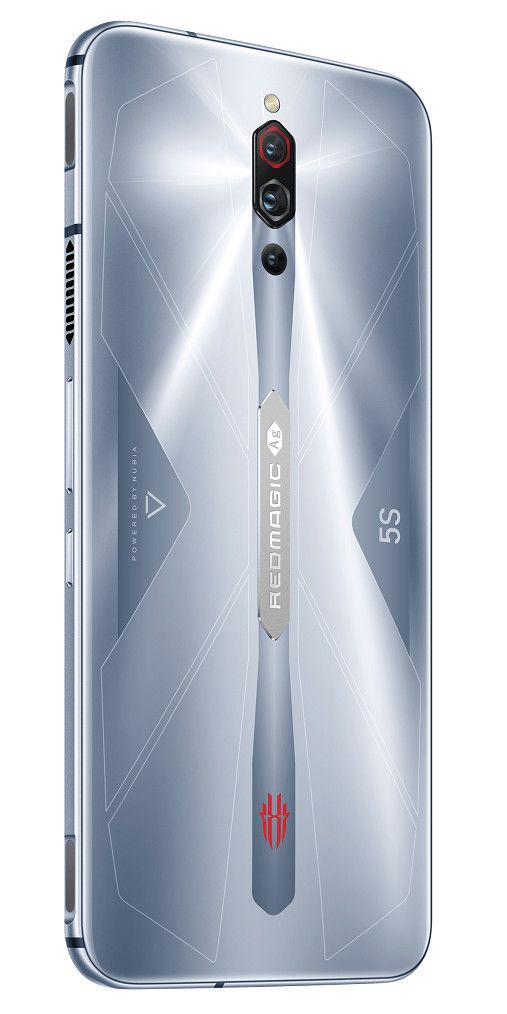Over the summer, Nubia unveiled its latest gaming smartphone, the Red Magic 5S, which was subsequently made available in China. Now, Nubia is launching that device globally along with a sleek cooling attachment to keep you gaming longer.
Design-wise, the Nubia Red Magic 5S has a definite gamer-aesthetic, at least in the Pulse color variant. The choice of color in the Sonic Silver variant is a bit more muted in contrast. Both variants have a metal mid-frame and glass back cover (with a layer of 2.5D Corning Gorilla Glass for some protection.) On the bottom, you’ll find the USB Type-C port, a microphone, the dual SIM card tray, and the bottom-firing speaker; the other speaker is located at the top bezel. At the top, you’ll find the 3.5mm audio jack and a microphone. On the left, you’ll find the Game Space toggle, a pin connector for Nubia’s accessories, and one of the two cooling vents. The right side has the power button, volume rocker, the other cooling vent, and the two shoulder buttons.


As a gaming phone, you shouldn’t expect much from the Red Magic 5S in terms of camera hardware. It has a triple camera array on the rear which is comprised of a 64MP Sony IMX686, an 8MP wide-angle camera, and a 2MP macro camera. On the front, there’s a single 8MP camera. The camera app supports up to 8K@30fps video recording from the rear and 1080p@60fps from the front. Other camera modes include a pro photo mode, night mode, portrait mode, and more.
The Red Magic 5S features a 6.65-inch AMOLED display from Chinese display maker Visionox. The display takes up most of the front, with no notch or hole-punch cutout obstructing the view. The panel’s resolution is FHD+ while its refresh rate goes up to 144Hz. For fast gaming response times, Nubia says the touch sampling rate is 240Hz, the tap latency is 32.2ms, the slide latency is 45ms, and the gesture latency is 14.9ms. Nubia says the display has received TÜV Rheinland’s low blue light certification and features DC Dimming to reduce eye strain from OLED flickering. The display also supports 4,096 levels of brightness control and 100% of the DCI-P3 color gamut. Underneath the display is an optical under-display fingerprint scanner.
Internally, the Nubia Red Magic 5S is powered by the Qualcomm Snapdragon 865 SoC and not the overclocked Snapdragon 865 Plus. Choosing the former undoubtedly lowered the cost a bit without compromising on performance in a way that most users will care about. The chipset is paired with Qualcomm’s Snapdragon X55 modem for 5G connectivity. It’s also paired with up to 12GB of LPDDR5 RAM, which is more than enough to handle all your multitasking needs, and up to 256GB of UFS 3.1 non-expandable internal storage. For long-lasting gameplay, the Red Magic 5S features a 4,500mAh battery and supports Nubia’s proprietary 55W Quick Charge technology. However, the device will only come with an 18W Qualcomm Quick Charge 3.0 charger in the box.
Besides packing Qualcomm’s latest silicon, the Red Magic 5S features a couple of additional hardware and software features to elevate the gaming experience. Nubia’s “ICE 4.0 active liquid-cooling system” is comprised of multiple layers of cooling technology, including a layer of graphite, a liquid cooling tube, a copper plate, a silver plate, and an internal fan, all of which are automatically activated when the 10 temperature sensors in the device detect critical heat levels. Then there are the aforementioned shoulder buttons which are touch-sensitive with 320Hz touch sampling rate. The dedicated Game Space button on the left side means you’re never far from launching your favorite game.
In terms of software, the device runs Nubia’s Red Magic OS 3.5 based on Android 10. Nubia says the Red Magic 5S (and the Red Magic 5G, for that matter) will get an update to Android 11, but there’s no date on when the update will roll out. Software support will last 2-2.5 years, according to the company.
Nubia Red Magic 5S Forums
Nubia Red Magic 5S Specifications
| Specification |
Nubia Red Magic 5S |
| Dimensions and Weight |
- 168.56 x 78 x 9.75 mm
- 218g
|
| Build Material |
Metal Middle Frame + Glass Back Cover |
| Display |
- 6.65-inch Visionox AMOLED;
- 2340×1080 resolution
- 19.5:9 aspect ratio
- 144Hz high refresh rate
- 240Hz touch sampling rate, 32.2ms tap latency, 45ms slide latency, 14.9ms gesture latency
- 600 nits max brightness, 4,096 levels of smart brightness control
- 2.5D Corning Gorilla Glass
- 100% DCI-P3
|
| SoC |
Qualcomm Snapdragon 865
- 1x Kryo 585 (ARM Cortex-A77-based) Prime core @ 2.84GHz
- 3x Kryo 585 (ARM Cortex-A77-based) Performance core @ 2.4GHz
- 4x Kryo 385 (ARM Cortex A55-based) Efficiency cores @ 1.8GHz
Adreno 650
|
| RAM and Storage |
-
- 8GB LPDDR5 + 128GB UFS 3.1
- 12GB LPDDR5 + 256GB UFS 3.1
|
| Battery & Charging |
- 4,500 mAh battery
- Up to 55W fast charging, 18W Qualcomm Quick Charge 3.0 in the box
|
| Rear Cameras |
- Primary: 64MP Sony IMX686, 0.8μm pixel size, f/2.0 aperture, 78.3° FoV
- Secondary: 8MP HI846 Wide-Angle Camera, 1.12μm pixel size, f/2.0 aperture, 120° FoV
- Tertiary: 2MP OV02A10 Macro Camera, 1.75μm pixel size, f/2.0 aperture, 78° FoV
- Video recording: 8K@30fps, 4K@60fps
- Slow Motion: 1080p@240fps, 720p@480fps
|
| Front Camera |
8MP, 1.12μm, f/2.0 aperture, 1080p@30fps video |
| Security |
Optical under-display fingerprint scanner |
| Connectivity |
- SA+NSA:
- 5G Full Netcom SA+NSA
- Dual SIM & Dual Standby
- 5G:
- 2G+3G+4G:
- GSM 2/3/5/8
- WCDMA B1/2/4/5/8/19
- CDMA/EVDO BC0/BC1
- TD-LTE B34/B38/39/40/41
- FDD-LTE
- B1/B2/B3/B4/B5/B7/B8/B20/B12/B17/B18/B19/B26
- Wi-Fi: WiFi 6 2×2 MIMO
- Bluetooth: Bluetooth 5.1
- Positioning: GPS
- NFC: Yes
|
| Ports |
- USB 3.0 Type-C (Display Output support)
- 3.5mm headphone jack
- Dual nano-SIM card slot
|
| Audio |
- Dual Stereo Speakers with smart power amplifiers
- DTS:X Ultra, 7.1-channel surround sound
- 4D Shock vibration feedback
|
| Gaming Features |
- ICE 4.0 active liquid-cooling system with an internal rotating fan within the phone
- Low latency game screencasting
- Touch-sensitive shoulder buttons with 320Hz touch sampling rate
- Side pins for further docking
- Game Space 2.1
- GPU Boost
- Touch Choreographer
- Macro 2.0
|
| Android Version |
Red Magic OS 3.5 based on Android 10 |
| Colors |
Sonic Silver / Pulse |
Accessories
Nubia’s Red Magic Ice Dock cooling attachment can help keep the Red Magic 5S cool during intense gaming sessions. It’s powered by a USB-C port and clips onto the phone.

There’s also the Pro Handle gaming controllers that attach to the sides, a protective case, and a USB-C to HDMI adapter. The 55W PD Quick Charger is exclusive to the U.S. and Asian markets.
Pricing and Availability
The global version of the Red Magic 5S will be available in the following countries:
Nubia Red Magic 5S Availability
- North America
- Europe
- Austria
- Belgium
- Bulgaria
- Croatia
- Cyprus
- Czech Republic
- Denmark
- Estonia
- Finland
- France
- Germany
- Greece
- Hungary
- Italy
- Latvia
- Lithuania
- Luxembourg
- Malta
- Netherlands
- Poland
- Portugal
- Romania
- Slovakia
- Slovenia
- Spain
- Sweden
- UK
- Rest of world
- Australia
- Hong Kong
- Indonesia
- Israel
- Japan
- Kuwait
- Macao
- Saudi Arabia
- Singapore
- UAE
Nubia will offer the Red Magic 5S in two configurations: 8GB RAM/128GB storage in Sonic Silver for $579/€579/£539 and 12GB RAM/256GB storage in Pulse for $649/€649/£599. Pre-orders start today while open sales begin on September 2nd on
redmagic.gg.
Nubia Red Magic 5S Forums
The post Nubia Red Magic 5S gaming smartphone with the Snapdragon 865, 144Hz display launches globally for €579/$579 appeared first on xda-developers.
from xda-developers https://ift.tt/32oRj8N
via
IFTTT








